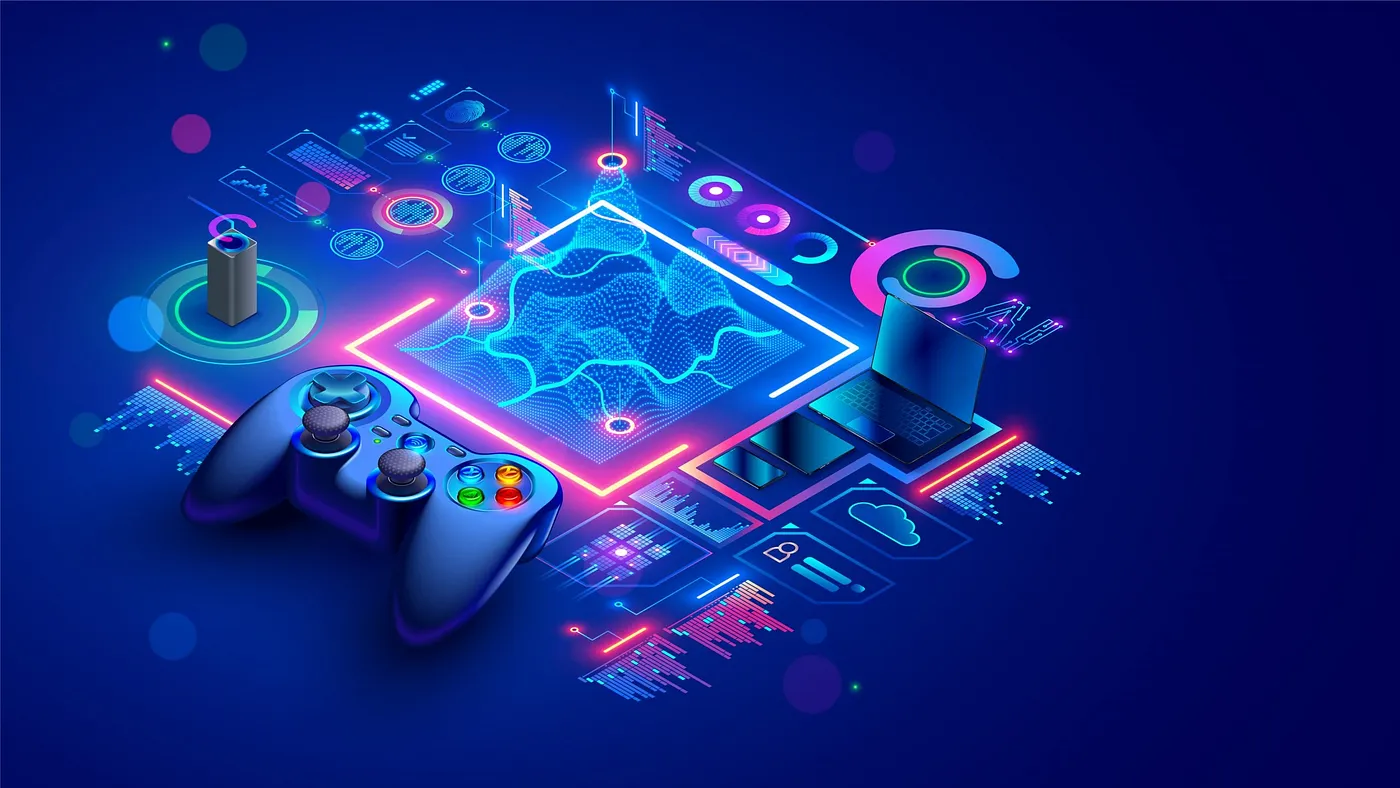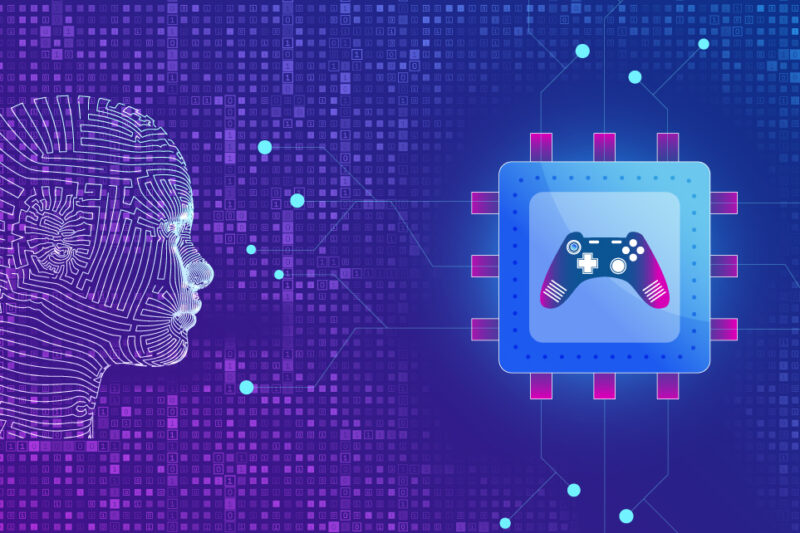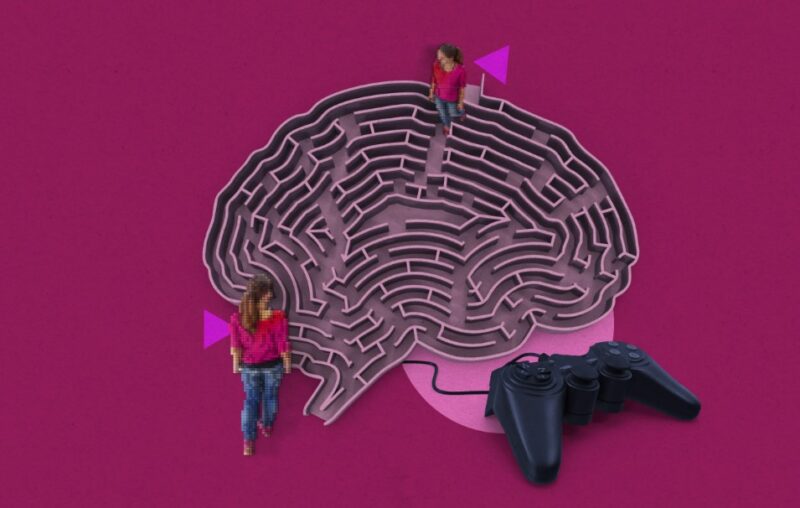Artificial Intelligence – the buzzword making the headlines for a couple of years now. Still a divisive concept, it’s fair to say that it’s gone truly mainstream. But, did you know that some tech industries have been implementing AI as a helpful tool for decades? Case in point: the gaming industry.
Going way back to the start of home video gaming, developers have experimented with AI, looking for ways to automate key processes in the creation of games. Recently, though, artificial intelligence programs have become so sophisticated that the technology is now a major transformative force in the gaming industry.
From facilitating dynamic storytelling to supporting adaptive difficulty features in recent SciFi video games, and even the emergence of “intelligent” NPCs (non-playable characters), AI is reshaping the landscape of digital interaction and entertainment.
In this article, we’ll take a closer look at the evolution of AI within the gaming industry, examining the various ways it’s used in the production of digital gaming experiences and speculating on what the future has in store.

The Timeline of AI in Gaming
As mentioned above, artificial intelligence has actually been utilized in video gaming since the industry’s earliest days. It was during the late 1970s and early ‘80s that it became a staple feature, supporting and enhancing the player experience even in the most simple of games.
The development of Pac-Man (1980), for example, involved integrating simple state algorithms to vary the behavior of the yellow critter’s ghostly enemies. Just a few years later, 1986’s The Legend Of Zelda delivered an early glimpse at the potential of AI to enhance video games, with its enemy AI feature providing an extra challenge to players.
While those foundational mechanics set the stage, modern experiments with AI have unleashed a spectrum of applications and use cases. One particularly relevant development has been the integration of machine learning, which enables games to adapt to individual players. The 2017 game, Middle-earth: Shadow of War introduced the Nemesis System, an innovative AI feature that allows NPCs to dynamically evolve based on player interactions.
In parallel with in-game integration, the use of artificial intelligence in game design processes has also expanded over the past decade or so. Procedural Content Generation (PCG) makes use of AI to help design expansive worlds with minimal human input. Exemplary games include the likes of No Man’s Sky, which uses PCG to generate infinite variations so that each player’s experience of the game is entirely unique to them.
Types of AI Games
So, we’ve covered the various ways in which AI has become indispensable in modern video game development, but does its scale extend to creating entire video games? The answer’s yes! Advanced AI systems like generative AI are driving new categories of games, which are either completely powered by these advanced systems or feature significant contributions.
These games can largely be broken down into four different types: AI text or adventure games, AI-generated games, generative AI games (yes, this is a different category to games that are AI-generated), and games with advanced AI technology.

Let’s explore these categories in more detail…
AI Text and Story Games
If you’re old enough to remember games like Zork or The Hobbit, you’ll get a warm sense of nostalgia from playing AI text and adventure games. Titles in this category use tech similar to that which powers language-processing chatbots like ChatGPT, but they offer a lot more than just being a throwback to these old-school games.
Due to the sophistication of advanced artificial intelligence systems, games such as AI Dungeon provide limitless possibilities despite their low-fi designs.
AI-Generated Games
Okay, so the category mentioned above technically incorporates AI-generated games, but since their format is widely different, they do stand alone as a separate category. When talking about AI-generated games, we mean those titles that play more like conventional video games.
For instance, This Girl Does Not Exist plays like a classic puzzle video game, but it’s been completely generated by an AI model. This is still very much a new category, so it also includes games with a significant contribution from AI models. However, as the tech only gets more advanced, we can expect to see many more AI-generated games hit the market in the not-too-distant future.

Generative AI Games
What, then, counts as a generative AI game? Well, games in this category feature AI-driven NPCs, assets, or in-game procedural generation. As we’ve mentioned before, procedural generation has been around for some time in gaming, but its capabilities have increased in line with the demand for immersive, high-quality digital gaming experiences.
As well as No Man’s Sky, the category includes premium games like Hades, Persona, and Diablo. With AI-driven NPCs being one of the most anticipated gaming trends, expect to see many more AAA titles with generative AI features in the months to come.
Games with Advanced AI Tech
Finally, this is more of a catch-all category for games that implement specific AI-driven functionalities to enhance gameplay and player experiences. Shadow of War is one such game, but we’d also include The Last of Us: Part II in this category, due to its unique “listen mode” feature.
The Evolution in Gaming
Artificial Intelligence in gaming has not only transformed gameplay but also revolutionized how players interact with digital environments and storytelling. One emerging trend is the rise of AI-driven personalization in multiplayer online games. By analyzing player behavior, AI can tailor gaming experiences to individual preferences, offering personalized quest lines, rewards, and challenges. This adds depth to the player experience, fostering engagement and loyalty.
Another fascinating application is the use of AI in improving accessibility in gaming. Adaptive technologies now allow individuals with disabilities to enjoy immersive experiences through AI-generated subtitles, real-time voice-to-text conversion, and customizable control schemes tailored to unique physical needs.
AI is also playing a significant role in moderating gaming environments. Tools powered by machine learning are being employed to detect and mitigate toxic behaviors in online communities. These systems can flag inappropriate content, ban cheaters, or reward positive player interactions, fostering safer and more inclusive gaming spaces.

Summary
Looking ahead, advancements in natural language processing could enable more nuanced interactions between players and NPCs, paving the way for characters capable of forming “relationships” with players. Combined with virtual reality, these developments hint at a future where gaming becomes a deeply personalized and emotionally engaging medium, blurring the lines between reality and virtual worlds.








